Last Wednesday, September 1, began our Orthodox Ecclesiastical New Year. Happy * New Year!
- In NT Greek, the word “happy” (makarios / μακάριος) also means “blessed”.
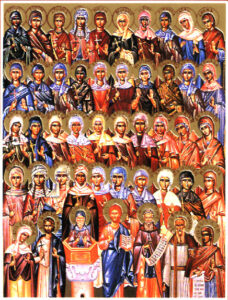 icon from Orthodox Church of America
icon from Orthodox Church of America
September 1 is also the feast of many saints. Among them is Saint Simeon Stylites – first row, first right from the Lord – whose lifestyle, you’ve got to admit, was more than a little peculiar.
Stylites are people who choose to live atop pillars. (Pillar = stylus, “pointed object”.) Saint Simeon the Stylite seems to have been the first of these.
One of the things that struck me when I first became Orthodox was how many… uh, well, “oddball” saints there are on the Orthodox calendar. The Anglican calendar (to which I was accustomed) contained “normal” saints, so to speak, chiefly men and women who had done good deeds of various sorts. The Orthodox calendar certainly has many of those. But Orthodoxy also has many saints who did bizarre things – lived alone in caves or on deserted islands, or who pretended to be out of their minds, or who sat in trees… or who dwelt on pillars. “Peculiar” saints.
Saint Simeon Stylites
He was born to Christian parents at the end of the Fourth Century in southern Cappadocia – now Turkey, near to the Syrian border. (Don’t go there today!) 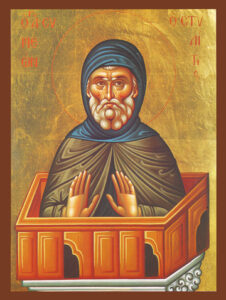 He was drawn to the monastic life, and when he was eighteen or so received the monastic tonsure. But he gave himself over to such extreme asceticism – great abstinence, unceasing prayer – that the igumen (abbot) finally told Simeon either to “cool it” or leave the monastery.
He was drawn to the monastic life, and when he was eighteen or so received the monastic tonsure. But he gave himself over to such extreme asceticism – great abstinence, unceasing prayer – that the igumen (abbot) finally told Simeon either to “cool it” or leave the monastery.
with permission of Saint Isaac’s Skete at skete.com
So he left the monastery. For a while he lived alone in an empty well in the mountains. But after a while, the igumen got worried about him and found him and directed him to return to the monastery to become better shaped in monastic disciplines. (This story is similar to that of Saint John Chrysostom.)
But then Simeon left again, this time settling alone in a cave, where for three years he prayed and fasted. It was said that there he spent the entire Forty Days of Great Lent with neither food nor drink – twenty days standing, and (giving in to bodily sloth…) the other twenty days sitting. This would seem unlikely, except that later on his pillar in public view he did the same thing.
Simeon became truly holy, a saint, a channel of God’s holiness. How do we know this? Because “by their fruits you shall know them.” Matthew 7:20 When men and women are holy, God sends people to them to receive healing of whatever sort, or to hear words which will guide them and edify them – and Saint Simeon did not remain alone. Many came to him. It seems contrary to common sense, but it’s true, that certain saints who practice the most extreme asceticism, away from the world, also in time give the most practical, down to earth advice to people who live in the world. Where do they get it? God only knows! and He does.
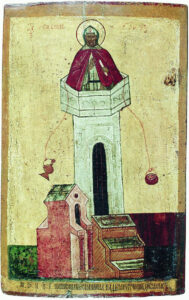 In Saint Simeon’s case, soon many were coming to his cave, seeking help. However, he also needed some isolation for prayer. So here was his creative solution: He found an abandoned pillar not far from modern-day Aleppo in Syria, six or eight feet above the ground. There he built a little hut, where he could enclose himself and escape from the crowds when he needed to, small enough that he could not lie down. But there he could also be accessible to those who came to him.
In Saint Simeon’s case, soon many were coming to his cave, seeking help. However, he also needed some isolation for prayer. So here was his creative solution: He found an abandoned pillar not far from modern-day Aleppo in Syria, six or eight feet above the ground. There he built a little hut, where he could enclose himself and escape from the crowds when he needed to, small enough that he could not lie down. But there he could also be accessible to those who came to him.
anonymous, 1465
In case you’re wondering about the “necessaries” (and you are) actually it was not so difficult: He ate very little, and his disciples could pass food up to him by rope. As for the rest… *
- Nobody had indoor plumbing till very recently in human history. I can remember those days on my grandparents’ farm not seventy years ago. I can remember… well, never mind. But how much we now take for granted.
To protect his ascetical life from the crowds, over the years Saint Simeon built his pillar ever higher, till it is said he was finally almost fifty (some say sixty, some say eighty) feet above the ground! with a double wall around it to protect him from the unruly.
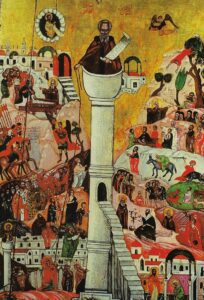 Unfortunately (for Simeon) and fortunately (for the world), as his pillar got higher it attracted even more people. Visitors came from far and near – literally, from all over the Empire. Some came only to see the wonder, as if to a carnival attraction. But others came seeking healing and advice – and on them Simeon had mercy. (Exactly how did he heal and counsel them from ‘way up there on his pillar? I don’t know.) We know he preached, defended the Orthodox Faith, and even converted many pagans.
Unfortunately (for Simeon) and fortunately (for the world), as his pillar got higher it attracted even more people. Visitors came from far and near – literally, from all over the Empire. Some came only to see the wonder, as if to a carnival attraction. But others came seeking healing and advice – and on them Simeon had mercy. (Exactly how did he heal and counsel them from ‘way up there on his pillar? I don’t know.) We know he preached, defended the Orthodox Faith, and even converted many pagans.
anonymous, before 1667
Patriarch Domninos II (441-448) of Antioch visited Saint Simeon, celebrated Divine Liturgy up on the pillar and gave the Holy Eucharist to Simeon.
When his mother came, he refused to see her, saying “We shall meet in heaven.” He must have had his reasons. She remained there till she died.
Elders living in the desert heard about Simeon and decided to test his obedience. They sent a message ordering him to come down. Simeon humbly prepared to obey and apparently was on his way down, so they directed him to return to his pillar.
Saint Simeon died on September 2 *, 459, age 69, having spent 37 years atop the pillar. A close disciple Anthony, distressed that his teacher had not appeared to the people for three days, climbed the pillar and found his master dead, stooped in prayer. Patriarch Martyrius of Antioch conducted the funeral before a huge crowd. They buried Simeon near his pillar, and there a monastery grew up.
- Why is he commemorated on September 1? I don’t know.
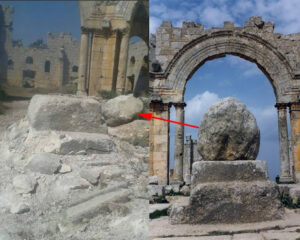 For centuries, Saint Simeon’s pillar was a place of pilgrimage. However, it was severely damaged during the recent Syrian War. Then, according to Richard Spencer in The Telegraph, May 13, 2016, “the church was captured by the Kurdish YPG/YPJ but was subsequently lost to factions opposing the Assad government. In May 2016 the Russian Air Force * attacked the church, damaging the remains of the pillar of St Simeon as well as the rest of the ruins.”
For centuries, Saint Simeon’s pillar was a place of pilgrimage. However, it was severely damaged during the recent Syrian War. Then, according to Richard Spencer in The Telegraph, May 13, 2016, “the church was captured by the Kurdish YPG/YPJ but was subsequently lost to factions opposing the Assad government. In May 2016 the Russian Air Force * attacked the church, damaging the remains of the pillar of St Simeon as well as the rest of the ruins.”
- the Orthodox Russians…!
The image above showing what’s left is from Archaeology News Network
For more information, see: https://en.unesco.org/news/director-general-unesco-deplores-severe-damage-church-saint-simeon-world-heritage-site-syria
courtesy of “Orthodoxy Sharing” website
“You were a pillar of patient endurance, having imitated the forefathers, O Venerable One: Job in suffering, and Joseph in temptations. You lived like the bodiless ones while yet in the flesh, O Simeon, our Father. Beseech Christ God that our souls may be saved.”
More Stylites
Saint Simeon inspired a whole contingent of other stylites. I remember Father Tom Hopko commenting that he thought most of them were “nuts” (to use his word), but that among them were some genuine saints.To mention only a few: Saint Daniel the Stylite, Fifth Century, for thirty three years lived atop his pillar just outside Constantinople. Saint Simeon Stylites the Younger (“of the Wonderful Mountain”) lived in the Sixth Century near Antioch. Saint Luke the Stylite lived in the Tenth Century on Mount Olympus. I read that there have even been a few female stylites. There were stylites into the 15th century. in Russia. (I sincerely hope they had some heat in their huts!) The practice never really caught on in the West,
There has remained one stylite in the country of Georgia.
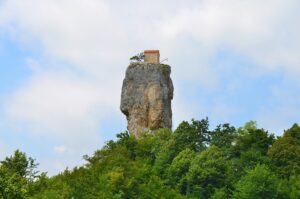
by Jaba1977 (Creative Commons License)
This is the chapel of Saint Maximos the Confessor. Look closely: To the left is a little hut where lives (lived?) the Monk Qavtaradze. Read his fascinating story here:
https://www.huffpost.com/entry/katskhi-pillar-monk-georgia-maxime-qavtaradze_n_3950192
https://www.cnn.com/travel/article/katskhi-pillar-georgia/index.html
Other Peculiar People
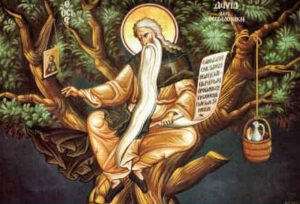 One of my favorites (for reasons I can’t explain) is Saint David of Thessaloniki the Dendrite – from the Greek word “dendron / δένδρον” which means “tree”. David, at the direction of God, went up into an almond tree and said he would stay there till God told him to come down. (He must have built a sort of tree house – a child’s dream! – up there.) Three years later God told him to descend, and thereafter he became an ascetic of some influence, even was called to visit the Emperor in Constantinople. See my Post: https://frbillsorthodoxblog.com/2018/09/07/82-three-saints-who-made-me-love-them-david-the-tree-dwller-martin-the-merciful-the-venerable-bede/
One of my favorites (for reasons I can’t explain) is Saint David of Thessaloniki the Dendrite – from the Greek word “dendron / δένδρον” which means “tree”. David, at the direction of God, went up into an almond tree and said he would stay there till God told him to come down. (He must have built a sort of tree house – a child’s dream! – up there.) Three years later God told him to descend, and thereafter he became an ascetic of some influence, even was called to visit the Emperor in Constantinople. See my Post: https://frbillsorthodoxblog.com/2018/09/07/82-three-saints-who-made-me-love-them-david-the-tree-dwller-martin-the-merciful-the-venerable-bede/
There are some well known Peculiar People. For example:
Saint Antony the Great who lived alone in the desert for decades, then emerged as a totally “put together” man, full of wisdom, a superb counselor and monastic leader.
Saint Francis of Assisi. You know about him and the birds, but there’s much more to him than that. We’ll talk about him next month. (But is he really an Orthodox saint? you ask.)
Saint Seraphim of Sarov who spent years alone in the Russian forest, by day praying atop a rock, and who emerged to become probably the most practical and beloved healer and counsellor of Russia, mobbed daily by crowds who sought his wisdom.
Or take the Fools for Christ. Russian Orthodoxy seems to 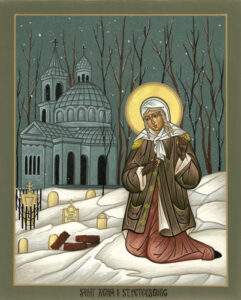 specialize in these: Saint Basil the Fool of Moscow, who feigned insanity and so was able to get by with criticizing Czar Ivan the Terrible. And Saint Xenia of Saint Petersburg, who after her prominent husband’s death wore his clothes, lived in poverty on the streets and secretly served the poor.
specialize in these: Saint Basil the Fool of Moscow, who feigned insanity and so was able to get by with criticizing Czar Ivan the Terrible. And Saint Xenia of Saint Petersburg, who after her prominent husband’s death wore his clothes, lived in poverty on the streets and secretly served the poor.
courtesy of pravmir.com
And a multitude more.
What to make of all these strange people?
I think the message to us today is summed up in the old “pop” saying “Different strokes for different folks”! People today, at least in our culture, make little room for eccentricity. (We love it on television and in the movies, but aren’t very tolerant of it in person.) But so long as people are doing nothing immoral or sinful, there should be room in the Church for all sorts of “odd ducks”. Who knows how God may use these people for the benefit of the world?
Finally, one more Peculiar Person
There was this young Man scarcely thirty years old, who contrary to the rules of His society, never married, never settled down. He traveled from town to town followed by twelve young men and often a group of women, and it’s pretty obvious who they are, people thought. He irritated and challenged the city elders almost everywhere He went and sometimes even got thrown out of town.
with permission of Saint Isaac’s Skete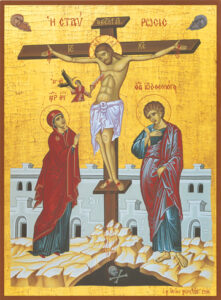
In the end the civil and religious authorities decided that for the good of society they must to get rid of Him, so they sentenced Him to death. He died as a criminal on the ancient equivalent of an electric chair. A peculiar Case indeed.
And yet another?
So… … Do you perhaps feel God is calling you to perch on a pillar, or do something else off-beat? He might be.
But, please, test that calling carefully, very carefully. Is it really God calling you or is it just an inner delusion? Think. Pray. Consult with someone – make sure you have a trusted, competent, spiritual father or mother to advise you. (If heights make you shaky, as they do me, the advice will be that you are not called to be a stylite.) There is always the danger that you’ll only throw your life away, making a fool of yourself “in the sight of men”, or even worse in the sight of God. As Father Tom said, most people who sit on pillars by themselves are “nuts”. Or maybe being up there by themselves makes them go nuts. The Church is a community. Most of us need other people. Even Saint Simeon did in his own peculiar way.
 Furthermore, consider the fact that you may already be sufficiently eccentric enough. For you, dear Orthodox sister or brother, are already a Peculiar Person.
Furthermore, consider the fact that you may already be sufficiently eccentric enough. For you, dear Orthodox sister or brother, are already a Peculiar Person.
You may paste the image of your peculiar face in here.
Think how odd you look in the sight the many “worldly” people in this world: On Sunday morning, when you could be sleeping in or having a nice brunch, what do you do? You go off to worship a God you cannot see, who seem be three Gods but we say they are actually One. You follow and serve that peculiar young Man who died 2000 years ago as a criminal. You give money (which you could be spending on your pleasures) to support an antiquated, outdated Church (as many think), and at your Lord’s command you give to the needs of the poor (who many say don’t deserve it). You spend time at home praying to that same invisible God and asking the help of people who died centuries ago and staring at their pictures, even kissing them, for heaven sake! Truly bizarre. You seek truth and guidance, not from the latest “pop” author or TV personality, but from a Book which is 2000 years old. And even now: here you are wasting your time reading this Blog.
If that isn’t super-peculiar in the eyes of the world, I don’t know what is. You, dear ones, have already joined the ranks of the Peculiar People.
And for that, God will bless you.
Next Week: The story of Saint Euphrosynos the Cook
Week after next: Justification by Faith, as we try to clean up the mess Saint Anselm made and the Protestants bought into
Dear Father Bill–this is one of your best! Thank you.
Very interesting and enjoyable to read. I love your blog!